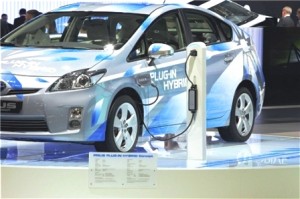Costs of plug-in hybrid electric cars are high — largely due to their lithium-ion batteries — and unlikely to decrease drastically in the near future, claims a new report from the National Research Council.
Costs to manufacture plug-in hybrid electric vehicles in 2010 similar to the Chevrolet Volt are estimated to be as much as $18,000 more than for an equivalent conventional vehicle, $14,000 for the battery pack alone. And the cost estimates in the report are incremental manufacturing costs. They do include engineering and overhead costs, or the profits that automakers will try to pass on to customers.
Although a mile driven on electricity is cheaper than one driven on gasoline, it will likely take several decades before the upfront costs decline enough to be offset by lifetime fuel savings.
Subsidies in the tens to hundreds of billions of dollars over that period will be needed if plug-ins are to achieve rapid penetration of the U.S. automotive market.
Worse, even with these efforts, plug-in hybrid electric vehicles are not expected to reduce oil consumption significantly or carbon emissions before 2030.
The report looks at plug-ins that can operate on electricity for 10 or 40 miles. A theoretical PHEV-10 is similar to the existing Toyota Prius, but with a larger battery. The PHEV-40 is similar to the Chevrolet Volt since it has a larger motor and a much larger battery than the PHEV-10 to get 40 miles of electric range.
While battery technology has been developing rapidly, real declines in cost do not appear likely over the next couple of decades because lithium-ion batteries are already produced in large quantities for cell phones and laptop computers. Thus, the economy of scale argument appears faulty, and, without a breakthrough, batteries will remain expensive, limiting market appeal.
In the first generation of production, the PHEV-10 battery pack is estimated to cost about $3,300, and the PHEV-40 battery pack about $14,000.
According to the committee that wrote the report, the maximum number of plug-in electric vehicles that could be on the road by 2030 is 40 million, assuming rapid technological progress in the field, increased government support, and consumer acceptance.
Incremental costs for plug-in hybrids by 2030 are estimated at $4,100 for the PHEV-10 and $11,000 for the PHEV-40, only slight decreases from today.
However, the high cost, limited availability of places to plug in, and market competition suggest that 13 million is a more realistic number, the report says.
Even this more modest estimate assumes that current levels of government support will continue for several decades.
Most of the electricity used to fuel these cars will be supplied from the nation’s power grid. If charged at night when the demand for electricity is lowest, the grid would be able to handle the additional demand for millions of plug-in hybrid electric vehicles, the report says.
However, if drivers charge their vehicles at times of high demand, such as when they get home from work, the additional load could be difficult to meet unless new capacity is added. So called “smart meters,” which bill customers based on time of use, may be necessary in order to encourage nighttime charging. In addition, some homes would require electrical system upgrades to charge their vehicle, which could cost more than $1,000, further adding to the cost problem.
Compared to hybrid vehicles, plug-in hybrid electric vehicles will have little impact on U.S. oil consumption before 2030, especially if fuel economy for conventional vehicles and hybrids continues to increase past 2020.
PHEV-10s save about 20% of the gasoline an equivalent hybrid vehicle would use, the report says. If 40 million PHEV-10s were operating in 2030, they would save about 0.2 million barrels of oil per day compared to less expensive hybrids, approximately 2% of current U.S. daily light-duty vehicle oil consumption.
Savings that are more substantial could be seen by 2050. PHEV-40s, which consume 55% less gasoline than hybrids, could have a greater impact on oil consumption.
Plug-in hybrid electric vehicles emit less carbon dioxide than equivalent conventional vehicles, but not less than hybrids after accounting for emissions at generating stations supplying their electrical power, the report says.
Beyond 2030, assuming consumer acceptance, a big if, plug-in hybrid electric vehicles could account for significant reductions in U.S. carbon dioxide emissions, if electricity generation plants fired by fossil fuels were equipped with carbon capture and storage systems or replaced with renewable energy or nuclear-powered plants. Copies of Transitions to Alternative Transportation Technologies — Plug-in Hybrid Electric Vehicles are available from the National Academies Press, 1-800-624-6242 or at http://www.nap.edu.

